

Multiple copies of the same frame can cause unrecoverable errors. Many protocols expect to receive only a single copy of each transmission.

Multiple-frame transmission-Multiple copies of unicast frames may be delivered to destination stations. This situation is commonly called a broadcast storm. Data forwarding can be impaired when the switch consumes the resources that are coping with instability in the MAC address table.īroadcast storm-Without some loop-avoidance process, each switch may flood broadcasts endlessly. MAC database instability-Instability in the content of the MAC address table results from copies of the same frame being received on different ports of the switch. A Layer 2 loop can result in three primary issues: When multiple paths exist between two devices on a network, and there is no spanning-tree implementation on the switches, a Layer 2 loop occurs.

Logical Layer 2 loops may occur due to the natural operation of switches-specifically the learning and forwarding process. However, redundant paths in a switched Ethernet network may cause both physical and logical Layer 2 loops. Redundant networks require the addition of physical paths, but logical redundancy must also be part of the design. Redundancy is an important part of the hierarchical design for preventing disruption of network services to users. For the redundancy to work in a systematic way, the use of OSI Layer 2 protocols, such as STP, is also required. OSI Layer 1 redundancy is illustrated using multiple links and devices, but more than just physical planning is required to complete the network setup.


 0 kommentar(er)
0 kommentar(er)
